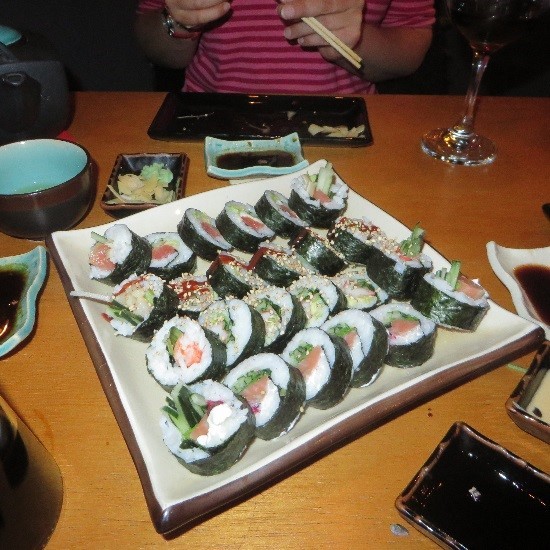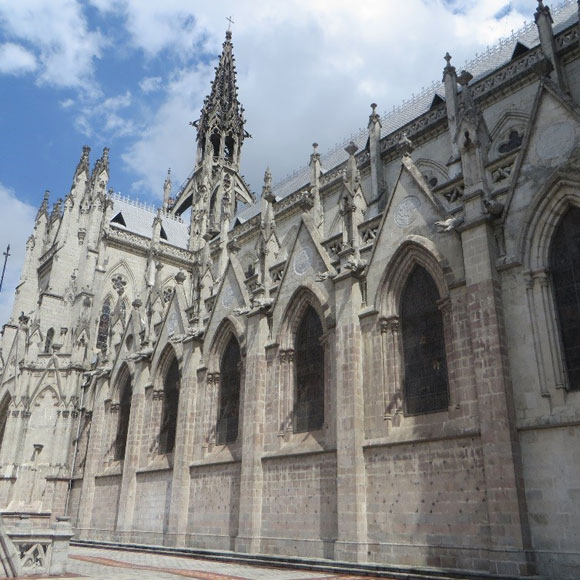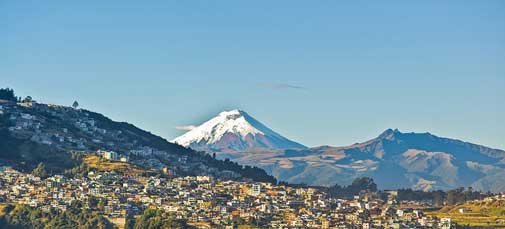By IL‘s Ecuador Insiders: Wendy DeChambeau, Suzan Haskins, Jim Santos, and Edd Staton
An Update on Ecuador’s Southern Coast
By Jim Santos
In October, my wife Rita and I rented a car and took a road trip up the Ruta Del Sol to see how things were progressing on the southern beaches of Ecuador six months after the April earthquake. We took a week and traveled from Salinas up to Canoa, staying at several places along the way. What we found was encouraging.
The good news is that things for the most part are progressing well. The roads are no problem at all, and there is really not any visible evidence of damage until you get to the city of Manta, which was just over 100 miles from the epicenter.
South of Manta, you’d be hard-pressed to find any signs that there was an earthquake. In our hometown of Salinas, 190 miles from the epicenter, we had a wild ride but no structural damages or loss of services. This was pretty much true all the way up to Puerto Lopez, 141 miles from ground zero.
Today, all is well in the coastal towns including Playas, Salinas, Montanita, Olon, Puerto Lopez, Salango, Santa Marianita, and all of the many little villages along that part of the Ruta Del Sol. The only problem they are having now is a drop-off in tourism. In general, the whole coast has seen tourist numbers fall, although there are recent signs that the crowds are starting to return.
In fact, Puerto Lopez looks better than ever. Work has been completed on their new malecon (boardwalk). The decorative brick walkway stretches well over a mile, and features bathrooms, benches, small restaurants, and more. Work is well underway on road improvements in town as well, making Puerto Lopez a great attraction for tourists and expats.
Even in the busy port of Manta, where you can still see buildings damaged by the quake, you can find repair and reconstruction taking place across the city. Walking around town and talking to expats and Ecuadorians, you can feel a sense of community and a positive attitude about the future. There is still some way to go, but people are thinking and planning ahead.
Scott and Jane Layman are just two of the expats in Manta determined to make a difference. They have been operating Manabi Marine Products and Manabi Marine Logistics for more than two years. MMP deals with Mercury marine products and boat repair/upgrades, and the Logistics business assists with importing. Since April, Scott and Jane have also been assisting local expats during the rebuilding phase.
When repairs are being made in a condo building, for example, insurance regulations often require that the owners remove their personal belongings from of the building until work is complete. Scott and Jane have been arranging move-outs, storing the goods in shipping containers, or in some cases, their own warehouse.
North of Manta, things are a little more mixed. The smaller villages of Crucita, San Jacinto, San Clemente, and San Vicente are all doing well. It seems to be business as usual there, although at a slower pace than normal. Everywhere we visited, the common cry was, “Tell people they can come back to the coast.”
The places still facing big challenges are Bahia de Caraquez and Canoa. Bahia, only 74 miles from the epicenter, took a lot of damage. Many of the high-rises were damaged, and their hospital was destroyed. The El Paseo Mall is up and running, services like water, gas and electricity have been working fine, and the bridge connecting Bahia to the northern shores was undamaged, but there is still much work to be done.
There is still a tent city at the Bahia bus station, and other tents can be seen throughout the town. The hospital has been replaced with a mobile unit, also operating under canvas. While work is being done on some of the buildings, there seems to be less organization than in Manta. In fact, talking to expats and some city workers, there were differences of opinion on whether some buildings could be repaired or whether they were scheduled for demolition.
Canoa is a different story. There are still some buildings as you approach town that need attention, but for the most part the town is ready for business. However, the crowds have been slow to return to this beautiful beach. What may be hurting Canoa right now, is that part of its attraction was a wonderful, rustic beach setting for surfing and more, less than a half-hour from the modern shopping and medical services of Bahia. So in that way, their fate is tied to Bahia’s recovery. The modern shopping is still there, but until the hospital is restored, the nearest major medical facility is in Manta or Porto Viejo, about two hours by car.
In short, if you have been holding off on visiting the southern beaches of Ecuador, you don’t have to wait any longer to come down and see the many beautiful places waiting for you. We plan on taking a tour of the northern beaches in the early part of 2017, so I’ll have first-hand information for you as soon as we return.
Living a “Pedestrian Lifestyle”
By Edd Staton
When we arrived at the Red Rock resort in Las Vegas for IL‘s Bootcamp conference last month, Cynthia was nursing a serious cold that required OTC medication. I learned from the concierge that the nearest pharmacy was about a half-mile from the hotel.
We had no rental car but, “No big deal,” I thought. “I walk pretty much everywhere in Cuenca anyway.” So off I went down Charleston Boulevard which, like almost all roads in Vegas, is as straight and flat as you can possibly picture.
Not far into my errand I noticed that I was the only person walking on either side of the road as far as I could see. This struck me as quite odd, because in Cuenca, pedestrians are always out and about on the sometimes narrow, and quite often, uneven sidewalks. Yet here I found myself totally alone on a beautiful wide walkway beside a bustling six-lane road.
On the solitary journey back to the resort, my mind drifted back to eight years ago, when Cynthia and I were initially thinking about moving overseas. As part of our process we made a checklist of desirable features in a new home abroad.
“Pedestrian lifestyle” was not included, simply because the idea never occurred to us. Like the citizens of Las Vegas and most everywhere else in the U.S., for most of our lives we got behind the wheel everywhere we went.
It turns out that walking has become so important to us that we now rank this activity right up there with cost of living and temperate climate (speaking of which, as I write this there is five inches of snow outside our daughter’s home in New Jersey…Yikes!).
You see, we’ve learned that walking offers benefits beyond its obvious contribution to physical fitness. For one thing, you are forced to slow down, which comes in especially handy when you are transitioning from the over-scheduled, over-stressed life you perhaps are leaving behind.
In a car with the windows up, the world outside whizzes by in a silent blur. Walking encourages you to actually be a part of your surroundings and an active participant in your life. You feel the sun on your shoulders and a soft breeze on your face. You hear birds singing, pause to admire beautiful blooming flowers, and often notice something new along a route you have traveled countless times.
IL conference attendees consistently and overwhelmingly rank walking as the number-one exercise they expect to do in their new lives overseas. After almost seven years in Cuenca where my feet are the primary means of transportation, I know they have much more to look forward to than they can imagine.
The ‘Bests’ of Quito
By Wendy DeChambeau
For most visitors to Ecuador, the capital city of Quito tends to be a quick stopover on the way in or out of the country. While I think Quito deserves more time and exploration, if you only have a day or two to spend there, you’ll want to make the most of it. With a population of nearly three million people, Quito is a big city with plenty of attractions and becoming overwhelmed is easy. Here are my picks for the best way to spend a short trip to Quito:
Best Eats
Sushi lovers must head directly to Shibumi for delicious sushi with a decidedly Ecuadorian twist. The owner/chef, Junior, is happy to make your sushi to order or you can let him surprise you with his own creations which include rolls encrusted with coffee grounds and pieces drizzled in passion fruit sauce.
 |
|
You can find Japanese cuisine with an Ecuadorian twist in Quito. ©Wendy DeChambeau |
You can find Shibumi at the corner of Ruiz de Castilla and Lorenzo Aldana. The restaurant is small, so it’s best to make reservations by calling ahead at (593) 099 1806 844.
Quito’s new food truck park is a great spot for lunch. Located in the La Floresta neighborhood, a vacant lot has been converted into a hip dining spot with more than a dozen food trucks and carts. Outdoor tables are covered with a free-standing roof where heaters are attached and strings of lights dangle from above. There’s something for everyone here with choices of burgers, hot wings, shawarma, tacos, traditional Ecuadorian food, desserts, and more.
Best City View
If you’d like a sprawling view of all of Quito, don’t miss your chance to ride the Teleferiqo (a gondola) to an altitude of 13,000 feet. You’ll be treated to a view of the valley through which Quito spreads as well as the gorgeous mountain peaks in the distance. If you’re okay with the high altitude you can do some hiking on the trails at the top or rent a horse for a trail ride. The cost for the Teleferiqo is $8.50 ($6.50 for those over age 65) or $4.90 if you are an Ecuadorian resident.
Best Historic Building
The Basilica del Voto Nacional simply cannot be missed while in the city. Not only is it the largest neo-Gothic basilica within the Americas, but it is distinctly Ecuadorian. You see, all of the gargoyles that adorn the outer walls are not frightening beasts, but instead native Ecuadorian animals. You’ll see jaguars, tortoises, monkeys, and more.
 |
|
The gargoyles that adorn the Basilica del Voto Nacional depict Ecuadorian animals instead of frightening beasts. ©Wendy DeChambeau |
For two dollars, you can climb the basilica’s two clock towers and look out above Quito’s Old Town and directly over to the statue of the Virgin of Cisne, which sits atop Panecillo Hill. If you’re extra adventurous, cross the wooden-plank bridge to the third tower on the opposite side of the building and then climb up three sets of steep ladders to reach the top. You’ll have splendid photo ops, but the bragging rights really make it worth it.
Best Theater
If you have the time to take in a show, see if anything is playing at Teatro Sucre (www.teatrosucre.com) in Old Town. This theater was built in the late 1800s and was originally patronized by Quito’s aristocrats. Today, dance performances, plays, and musicals all take place here. Last month I had the opportunity to see Les Miserables performed at Teatro Sucre and it was a memorable event. The history behind the theater and the outstanding performance made for a wonderful evening, but the best part was that I paid only $40 for my ticket. A performance of Les Mis in many other cities would be double or triple that cost.
Best Chocolate
I’ve saved the best for last. Any lover or even occasional partaker of chocolate must visit Cyril Boutique in Quito. This chocolatier and bakery serves up delicious pieces of art which are as tasty as they are beautiful. You can choose from individual chocolates (mix and match to fill a gift box) or larger pieces in the shapes of cats, fish, and turtles. Artisan breads, pies, and tortes make up the bakery side of the store and I would dare anyone to attempt to walk out of Cyril’s empty-handed. You can find the store on Irlanda and 6 de Diciembre as well as in the large Quicentro shopping mall.
Ecuador Election News Part II
By Suzan Haskins
Last month in your Ecuador Insider briefing, I wrote about Ecuador’s upcoming election and how refreshingly different it is from our process in the U.S.
The candidates filed applications to run on October 19, with approvals granted by the National Elections Council (CNE) on November 18. The election takes place this coming February 19. That’s just three months of campaigning—far less stressful than our U.S. system, in my opinion.
Campaigning is taking place now. There are eight parties, each with eight candidates running for president and other offices. Each political party is identified by a number, which is prominently featured in campaign ads in order to help reduce confusion.
The presidential frontrunner appears to be Lenin Moreno from the Alianza Pais party, also known as the Citizen Revolution—the same party as current President Rafael Correa. Jorge Glas, the current vice president, is running for re-election to that office.
Moreno is a lawyer and former vice president. He served in that role from 2007 to 2013. He has been in a wheelchair since being shot during a robbery in 1998 and has served as Special Envoy on Disability and Accessibility at the United Nations. His bio is here.
He currently holds about a 37% lead in polls over right-wing banker Guillermo Lasso from the Creating Opportunities (CREO) party; Cynthia Viteri of the Social Christian Party (PSC); former military member Paco Moncayo from the National Agreement for Change; and Dalo Bucaram—son of former president Abdala Bucaram—from Fuerza Ecuador.
Although Correa has been a fairly popular president, the Alianza party has been hurt by the country’s economic slowdown, caused by low oil prices, and by charges of corruption, especially in connection with the “Panama Papers.” You can read more about that here.
In public remarks, Moreno has said that if elected, he will continue to work toward providing free education and healthcare for children and adults, and to bolster other industries to ensure the country lessens its dependency on oil exportations.
As an expat with an official resident visa and a cedula (official ID card), you may vote in the upcoming election. The new constitution gives all permanent residents that right. Unlike citizens, you are not obligated, but you may vote.
If you opt into the voting process, you’ll get a Papeleta de Votacion (voter’s card)—identification that can be valuable for many government processes. If you’re thinking of eventually applying for citizenship in Ecuador, the Papeleta is one way of indicating that you’re invested in the future of the country and committed to its democratic processes.
Once you do start voting, though, you’ll likely be held to the same standards as Ecuadorians…meaning that if you don’t vote, you could be fined. Fines reportedly aren’t large, but this is something to keep in mind. If you are 65 or older, you are not required to vote, regardless of resident/citizenship status.
Keep in mind that if you are a registered voter and you move to another jurisdiction within the country, you’ll need to let CNE know so that they can register you in your new jurisdiction. If you don’t do that, you would need to travel to your prior jurisdiction to vote.
If you are living in Ecuador now, have registered to vote, and want to find out where to go on election day to cast your ballot, you can do that here with your cedula.
And now some personal news: My husband, Dan Prescher, and I are spending the next few months in Mexico’s Lake Chapala area with an eye to relocating there.
We love everything about Ecuador. But…Dan and I both have elderly parents in the States. And we now have a granddaughter that we didn’t have when we started our Ecuador journey so many years ago. The pull of family is strong.
For now, we’ll maintain our residence in Ecuador, and we’ll see what transpires over the coming months. I won’t be writing for the Ecuador Insider while we are in Mexico…but you can be sure you’ll hear about our experiences in Mexico as we’ll continue our work with International Living, writing for the magazine and the Daily Postcard e-letter, speaking at conferences, etc.
I wish you all a very Happy Holiday season. And I hope 2017 is the year your dreams of living overseas come true…in Ecuador or wherever they may take you. The world is your oyster and that oyster can contain many pearls.
Got a Question About Ecuador? We’re Here to Help
As your Insiders, we’re here to answer any questions you have about moving to and living in Ecuador. Post your questions on the members-only Ecuador Insider Forum where everyone can benefit from the answers.
So, no matter what you want to know, post your question on the forum and we will do our very best to help you out. Don’t forget that there’s also a search function on the forum, so you can check if your question has already been answered.
If you’d like to keep your question private, you can drop us an email at Ecuador@InternationalLiving.com (remember to use “Ecuador Insider” in the subject line). We look forward to hearing from you.

